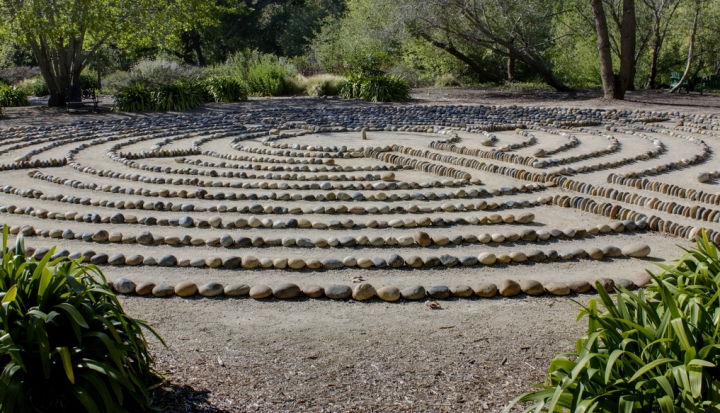According to Trappist Father Thomas Keating, a decades-long practitioner and teacher of centering prayer, contemplative prayer is about relationship, not method. It’s your intention and your relationship with God that counts.
I learned this firsthand during my two-month working retreat at a motherhouse, where I spent each Wednesday in silence. Silence defined as not only no in-person conversations but also no cell phones, no iPods, and no laptops. Each Tuesday night, I turned off my devices and stuck them in a drawer. I unplugged from my normal way of being in the world with the hope I would plug into that Divine Voice that is so easily drowned out by noise and activity. Knowing my own tendency to binge-read, I made a rule of no books on Wednesdays—since I knew I could spend a day reading about centering prayer and wind up never actually praying.
I felt my mind slowly unwind and my soul slowly expand as the buzz in my head gradually quieted. I walked. I swam laps. I sat in centering prayer in the meditation attic or in the Eucharistic chapel, my hands open on my lap. I journaled. I walked—without earbuds pumping music or podcasts into my ears—among the blue heron by the pond, the geese by the labyrinth, and the yellow finches by the pumpkin patch. There were moments of peace and sweet intimacy with God when I—with the psalmist—could say, “I have calmed and quieted my soul, like a weaned child with its mother” (Ps. 131:2). There were also uncomfortable moments when, out of the stillness and solitude, tough feelings like anger or sadness arose.
And, of course, there were plenty of moments of distraction—what Buddhists have described as “monkey mind.” I felt my thoughts bounce ping-pong-ball style back and forth from the past (Did I respond to that email? I wonder if my friends liked their wedding gift?) and future (I need to buy more coffee. I better return that library book tomorrow.). Over and over, I worked to return to inner stillness and to an awareness of God’s presence. Actually putting the psalmist’s words to “be still and know that I am God” into practice is more challenging than it seems. Henri Nouwen’s words that “the real ‘work’ of prayer is to become silent and listen . . . in spite of the many boisterous and demanding voices of our world” rang true Wednesday after Wednesday as I continued to grow in practice.
Through it all, I was acutely aware of, but sought not to engage, the nagging inner voice telling me this whole endeavor was ridiculous, self-indulgent, and a waste of time. The voice chided me: Instead of sitting in the chapel or walking through the fields, wouldn’t it be better to serve God through doing something practical? There were sisters in the infirmary who would appreciate a visit, there was that legislative alert email I’d received, and the parish needed some Spanish translation; the “get-it-done” voice inside me never failed to produce a list of things I should have been doing every Wednesday.
I’m solidly an extrovert on the Myers-Briggs Type Indicator® and not a natural fit for the contemplative silence of centering prayer. A goal-oriented person, I admit the thought of going more than an hour or two without a to-do list makes me nervous. Moreover, I am conscious of what a privilege it is to be able to take a silent day. Given my years of ministry in rural Latin America and among the working poor in the United States, I am painfully aware of how much of humanity works 60 or 70 hours a week just to scrape by. In light of this, how could I justify the “luxury” of a day each week dedicated to silence?
Trappist monk, poet, writer, and peace activist Thomas Merton wrestled with similar questions. He concluded that “the frenzy of the activist neutralizes his work for peace. It destroys his own inner capacity for peace. It destroys the fruitfulness of our own work.” His words resonate with my own experience. There is always another law to lobby, another crisis to respond to. It is easy for prayer to become that thing on our to-do list that we never get to. Ironically, we become cranky preachers of love, uncaring caregivers, harried activists for peace, and irritable advocates for justice. I have certainly seen this over my years of ministry. Merton goes so far as to call this overwork a “form of violence.”
After practicing a weekly day in silence for a summer, I believe that the only way the counter-intuitive and countercultural practice of contemplative silence makes sense is if it is based in both science—with its wild and wonderful theories of quantum entanglement, strange attractors, and the like—and scripture’s exhortation to pray. Both use their own language to point to the same reality: Our thoughts, intentions, and energy are real and make an impact.
My own experiences of being out on mission and sensing very deeply the prayers of others supporting and carrying me reinforce that reality. The felt sense of others’ prayer on my behalf has been a life raft that keeps me openhearted and compassionate in the midst of both personal losses and ministerial challenges.
While I haven’t continued with a weekly day in silence since that summer two years ago, I have spent a day in contemplative silence at the Trappist monastery near my home. It is a difficult practice to maintain: Life is busy. That inner voice clamoring for me to be productive hasn’t gone away, though it has been somewhat tamed.
I have come to believe that my silent, openhearted hours logged in the Eucharistic chapel, on the cushion in the meditation attic, and walking the land can mean something for this beleaguered, beautiful planet and the 7 billion human beings residing here. I am coming to trust that being—mirroring that ground of Being—can mean as much, if not more, than doing.
After a summer of this practice, it seems to me that contemplation is an end in itself and not a means to something else. Contemplative silence through/with/in God is not to be undertaken as part of a health or self-improvement regime. Nor is it an obligatory battery-charging pit stop on the road of apostolic work. It is—or at least aspires to be—uniting one’s own heart with the heart of God. Immaculate Heart of Mary Sister Sandra Schneiders, reflecting on the words of Thomas Merton, puts it beautifully: “In contemplative prayer, according to Merton, we pass through the center of our own being into the very being of God, where we see ourselves and our world with a clarity, a simplicity, a truthfulness that are not available in any other way.”
This article also appears in the July 2016 issue of U.S. Catholic (Vol. 81, No. 7, pages 45–46).
Image: Flickr cc via Sandy/Chuck Harris












Add comment